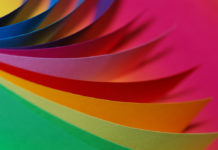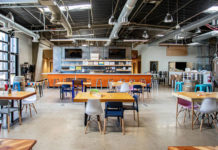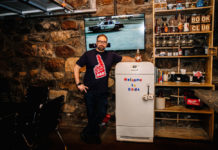For most bar and nightclub owners, it seems like a no-brainer: Lighting and sound are crucial parts of a nightlife venue. Interesting lighting and properly controlled sound can set the vibe for the entire place, and it’s important to go to the experts when setting up these elements for the first time or if you are doing a re-design. John Lyons of John Lyons Systems (www.avalonsound.com) and Tom Telesco of Telesco Associates (www.nightclub-design.com), are two of the heaviest hitters in the business when it comes to the lighting and sound on-premise, and Bar Business Magazine had the chance to sit down with each of them to talk shop.
Since sound and lighting design are two very different elements in a nightclub, it’s best to divide and conquer. Lyons, an expert in both sound and lighting, finds that when setting up your sound equipment, there are a lot of factors to take into consideration. First, the size of your space will completely determine the type of sound that is going to filter around the room. If you are boasting a 7,000-square-foot nightclub but using sound equipment for a 700-square-foot bar, chances are your sound is going to get lost in translation.
Over the past few years, Lyons has been working with speaker designers to come up with a way to face that challenge, developing a line of speakers that can achieve the level of clarity that you would need in a small, controlled space—such as a studio or a small living room—but suited for a large dance floor, all without using gigantic speaker boxes.
“I’ve worked with Fulcrum Acoustic (www.fulcrum-acoustic.com) to come up with speakers that have very high output while very compact, and they have special algorithms that have been developed to mitigate the mechanical distortion that goes with those kind of levels,” says Lyons. “When you have a speaker being driven that hard to those volumes, it’s difficult to not have some sort of distortion that is inherent. The algorithms that have been developed have allowed us to achieve remarkably high output and still maintain crystal clear clarity.”
Lyons has also worked on a collection of dance club speakers called The Avalon series that has been used in thousands of venues all over the world, with the next generation being installed in one of Lyons new Las Vegas client clubs, 1OAK.
This new technology—enabling your large space to have the sound clarity of a small space—is something truly unique in the industry, as most owners and operators struggle to obtain that perfect sound level, especially if they are working with a large space. Telesco, also an expert in the lighting and sound industry, has been working with a different kind of technology when it comes to sound installation to ensure that the audio experience in every space he designs is crystal clear. By focusing very heavily on the acoustics of a room, Telesco is able to calculate the reverberation in a space and install the proper equipment from there.
“I’m sure you’ve had the experience of going in a restaurant or bar, and even though the music wasn’t loud, the place was very loud,” says Telesco. “The ambiance and noise was just way up there. That’s because those places were designed without anybody paying attention to room acoustics.”
Spaces that have “hard or reflective finishes, such as ceramic tile or glass panels, walls that have hard treatments instead of soft fabrics,” says Telesco, are the most common environments for this kind of loudness. By measuring the acoustics during the planning phase, Telesco is able to install the proper panels, with the help of people who know the game.
“We work with acousticians who prescribe the right number and size of acoustic panels that can be hung on the wall or ceiling, because you can spend $400,000 dollars on the best sound system in the world but if you put it in a room that’s acoustically incorrect, you’re just going to have ordinary or poor sound,” says Telesco.
Now that you have attained the perfect sound levels in your venue, whatever size it may be, it’s time to make sure you have great lighting to compliment it. In Las Vegas, where the market is incredibly competitive, Lyons is able to push the envelope in the venues that he works with and deliver the newest and freshest technology when it comes to lighting.

“When you’re trying to design a space that really gives the audience something very new and fresh, you have to start with a blank slate and design from the ground up,” says Lyons. “In some cases, less is more. There are a lot of bars that want to just look nice and sound good, and then there are bars that present a sensory experience. Any time you have something meant to excite the senses, you have to approach it from that place. Just having a lot of flashing lights and loud speakers doesn’t really do it.”
Innovations in lighting are constant, and it’s important that as a bar owner, you take advantage of these upgrades to make your venue more modern and approachable to patrons. Telesco has seen major advancements in the lighting design category, specifically with the introduction of flat LED lights.
“Years ago we loved the idea of bar tops that glowed, and we used to create all these different ways to do so,” says Telesco. “Three or four years ago, we worked on a club called Score in Miami Beach, and we started using clear plastic 2x4s, where we set them up on the bar surface and put the top on, and we’d have our LED color-changing lights in between. The plastic 2x4s minimized the hot spot and dark spot you get with the lighting beneath a surface that is translucent.”
When it comes to updating your technology in terms of lighting and sound, it’s key to not only keep these basics in mind, but more importantly, bring in professionals to do the heavy lifting for you.
“One of the first things is to get a hold of two people: a lighting and sound specialist, but you also want somebody to address the acoustics,” says Telesco. “Even most sound people don’t do that. They’ll tell you where speakers should be placed for optimum coverage, but they aren’t going to know how to calculate the reverberation time or even think about it.
“With lighting, you can hire an independent consultant and there are a lot of great ones. They are generally better than the architectural interior designers because we cover a lot more area than they do in terms of what we need to know. They are specialists, and I think lighting and design should be handled by a lighting designer.”
Even the best bar owners can get caught up in what they think is smart lighting and sound design, but they don’t bring in the experts to point them in the right direction. “Sometimes they’re too far into the woods to see the trees,” Telesco says.
So get out of the woods, and into some new design.








